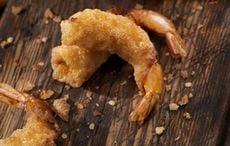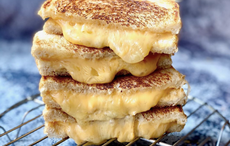This sweet college pudding recipe comes from a handwritten book by Mary Honner, which includes 170 culinary recipes.
This pre-Great Hunger recipe manuscript illustrated the varied diet and cooking skills among those who could afford it in Ireland.
Recipes for pickled salmon, salted salmon and in the popular dish of duck and peas and fowl “in the French style” are included. The book contains sweet and savory pudding recipes of both a baked and boiled variety along with recipes for preserved fruits, meat, fish and oysters.
This recipe has been adapted by University College Cork food and culinary historian, Regina Sexton. She has changed it slightly to suit modern tastes (using butter instead of suet) and renamed it in honor of George Boole, who wrote extensively in his letter on eating in Ireland during the Famine. This dessert is being served at formal university dinners throughout 2015 to mark the bicentenary of George Boole’s birth.
Read more: Cork dined on “turtle soup and champagne” during Ireland’s Great Hunger
These little puddings are wonderfully satisfying and made all the better when served hot with a sweet, buttery wine sauce.
In line with her instructions, these are baked in the oven rather than steamed. There was an immense range of baked and steamed sweet puddings in 19th-century recipe collections and the one that is remembered best and still enjoyed is the Christmas pudding. These puddings were usually served with a sweet sauce. They are quick and easy to make.
Here is a time-lapse video of Sexton making the pudding:
Serves 4
Oven 180 C/350F/gas 4
Four small pudding bowls, greased
Note: the US cup measures are approximate conversions. For best results use metric measures.
College Puddings
Ingredients
110g/4 oz. (.75 cup) raisins
2 tablespoons sherry
60g/ 2 ½ oz. (1 cup) breadcrumbs
50g/ 2 oz. (.63 cup) flour
½ teaspoon baking powder
1 – 1 ½ teaspoon freshly ground nutmeg
25g/1 oz. (.21 cup) candied lemon peel
75g/ 3oz. (.75 stick) butter
50g/2 oz. (.25 cup) caster sugar
1 large egg
6 tablespoons milk
Nutmeg and lemon for garnishing
Method:
Preheat the oven.
In a small bowl soak the raisins in the sherry for about an hour or until they have plump-up and absorbed all the liquid.
In a large bowl mix the flour, breadcrumbs, baking powder and sugar.
Mix in the raisins and candied lemon.
Gently melt the butter in a saucepan over a low heat and pour into the dry mixture along with the egg and milk.
Mix to a batter and then fill the greased pudding bowls.
Bake the puddings in a bain marie for 30 to 35 minutes or until a skewer comes out clean when inserted into the puddings.
Remove from the oven and leave to stand while you make the sauce.
Wine Sauce
Ingredients
25g/1 oz. (.25 stick) butter, softened at room temperature ½ teaspoon flour
120 ml/4 fl. oz. (3.8 US fl oz./.5 cup) water 40g/ 1 ½ oz. (.2 cup) caster sugar Rind of half a lemon, thinly sliced
180 ml/6 fl. oz. sherry, (5.75 US fl oz./.75 cup) sherry, Madeira or white wine
Method
Mix the softened butter with the flour and set aside.
Place the water, sugar and lemon peel in a heavy- bottomed saucepan.
Bring to the boiling stirring until the sugar has dissolved.
Turn down the heat and leave to bubble for c. 10- 15 minutes.
Strain the peel and leave the syrup on the heat for another minute or so until it starts to turn brown.
Remove from the heat, add in the butter/flour mixture and stir it through until you have a smooth thicken sauce.
Stir in the sherry, Madeira or white wine and serve immediately with the hot puddings.
To serve
Remove the puddings from the bowls and pour the hot wine sauce over each pudding.
Garnish with slivers of lemon peel and a little grated nutmeg.
Read more: A modern twist on the tradition Irish bread pudding recipe
~~~~~~
Commenting on this recipe and the book Sexton said “The recipe book is typical of the handwritten collections that started to appear in Ireland from the late 17th century.”
She continued “It contains the usual medley of culinary and medicinal recipes (such as snail tea or broth for consumption, colds and lung congestion) together with household tips, instruction for the care of animals and a few recipes of a cosmetic nature such as “tincture for the teeth” and “to prevent hair falling.
“Dishes typical of an Irish tradition, such as potato and soda bread recipes appear alongside those that are representative of Britain’s Imperial status.”
According to Sexton the food situation during the Famine and afterwards was very mixed in Cork. People starved while others had plenty.
As the potato crops failed, grain was exported and as George Boole found there was no shortage of food to be had if you had the money to buy it.
“Boole’s observations are a reminder of the complexities of the Great Famine and they throw up issues such as food security and food poverty, which are very relevant today,” she added.
* Originally published in 2015.




Comments